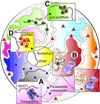Long noncoding RNAs: cellular address codes in development and disease
- PMID: 23498938
- PMCID: PMC3651923
- DOI: 10.1016/j.cell.2013.02.012
Long noncoding RNAs: cellular address codes in development and disease
Abstract
In biology as in real estate, location is a cardinal organizational principle that dictates the accessibility and flow of informational traffic. An essential question in nuclear organization is the nature of the address code--how objects are placed and later searched for and retrieved. Long noncoding RNAs (lncRNAs) have emerged as key components of the address code, allowing protein complexes, genes, and chromosomes to be trafficked to appropriate locations and subject to proper activation and deactivation. lncRNA-based mechanisms control cell fates during development, and their dysregulation underlies some human disorders caused by chromosomal deletions and translocations.
Copyright © 2013 Elsevier Inc. All rights reserved.
Figures




References
Publication types
MeSH terms
Substances
Grants and funding
LinkOut - more resources
Full Text Sources
Other Literature Sources

